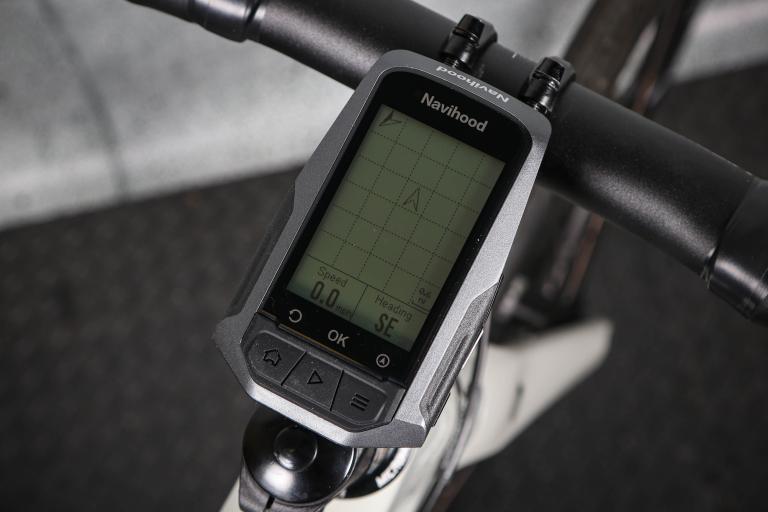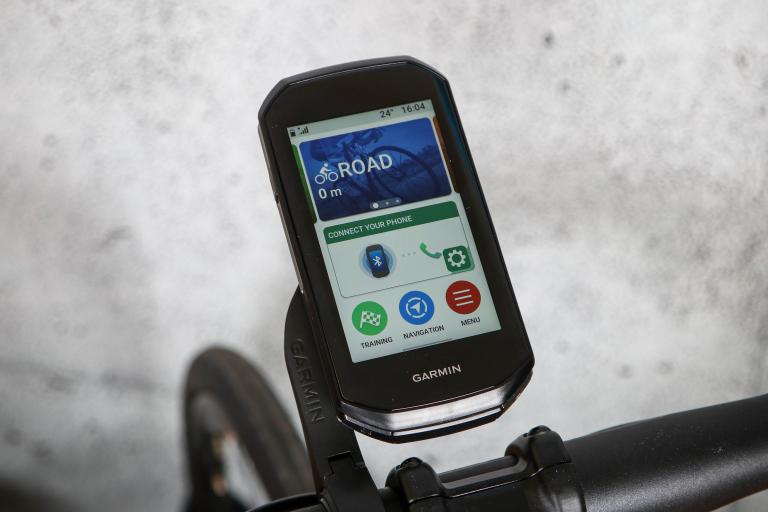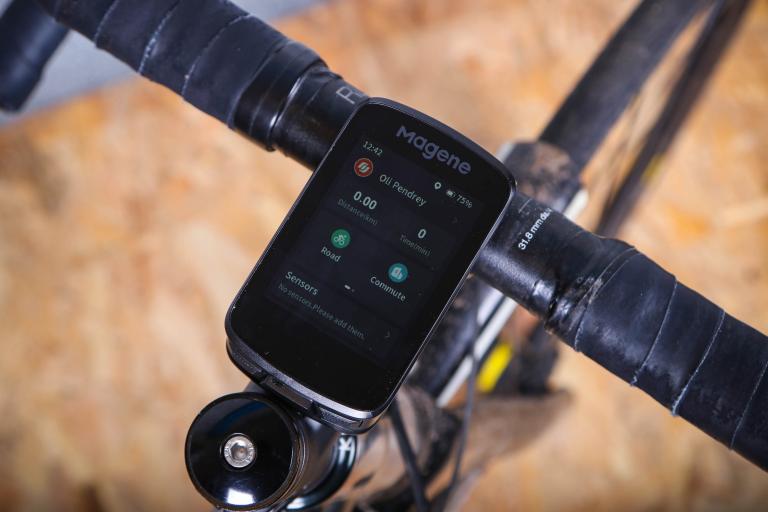- News
- Reviews
- Bikes
- Accessories
- Accessories - misc
- Computer mounts
- Bags
- Bar ends
- Bike bags & cases
- Bottle cages
- Bottles
- Cameras
- Car racks
- Child seats
- Computers
- Glasses
- GPS units
- Helmets
- Lights - front
- Lights - rear
- Lights - sets
- Locks
- Mirrors
- Mudguards
- Racks
- Pumps & CO2 inflators
- Puncture kits
- Reflectives
- Smart watches
- Stands and racks
- Trailers
- Clothing
- Components
- Bar tape & grips
- Bottom brackets
- Brake & gear cables
- Brake & STI levers
- Brake pads & spares
- Brakes
- Cassettes & freewheels
- Chains
- Chainsets & chainrings
- Derailleurs - front
- Derailleurs - rear
- Forks
- Gear levers & shifters
- Groupsets
- Handlebars & extensions
- Headsets
- Hubs
- Inner tubes
- Pedals
- Quick releases & skewers
- Saddles
- Seatposts
- Stems
- Wheels
- Tyres
- Health, fitness and nutrition
- Tools and workshop
- Miscellaneous
- Buyers Guides
- Features
- Forum
- Recommends
- Podcast
review
 Polar CS500 Computer
Polar CS500 Computer£314.98
VERDICT:
Highly featured, highly capable cycling computer, but highly expensive too
Weight:
51g
Contact:
www.polar.fi
At road.cc every product is thoroughly tested for as long as it takes to get a proper insight into how well it works. Our reviewers are experienced cyclists that we trust to be objective. While we strive to ensure that opinions expressed are backed up by facts, reviews are by their nature an informed opinion, not a definitive verdict. We don't intentionally try to break anything (except locks) but we do try to look for weak points in any design. The overall score is not just an average of the other scores: it reflects both a product's function and value – with value determined by how a product compares with items of similar spec, quality, and price.
What the road.cc scores meanGood scores are more common than bad, because fortunately good products are more common than bad.
- Exceptional
- Excellent
- Very Good
- Good
- Quite good
- Average
- Not so good
- Poor
- Bad
- Appalling
One of the most advanced bicycle computer designs on the market, both in terms of function and design, the Polar CS500 looks quite daunting fresh out of the box.
Designed for “ambitious cyclists seeking improved cycling performance”, the CS500 features a full catalogue of functions to enable its user to measure almost every aspect of their performance on the bike. Featuring traditional functions such as speed (current, average and maximum), distance (trip, lap and total), cadence (optional), power (optional) and time functions – it is also equipped with an altimeter to give you altitude, rate of ascent / descent and gradient information, as well as a thermometer and, given it is made by Polar, the expected ECG accurate heart-rate monitor. All this displayed on an easy to read, oversize display.
The first thing you notice about the unit is the Polar “Dual Lock” bike mount, and the lack of visible buttons. Designed to fit onto either the handlebars or the stem, the mount secures the unit via a pin running the length of the computer that enables it to tilt left and right in position. The major functions are then all accessed by pressing the left and right sides of the unit, which presses a pair of buttons on the rear against the mount. Polar says this makes it easier to access the functions on the move, as you do not need to reach for small controls while pedalling. A little gimmicky possibly, but I would tend to agree, and it certainly keeps the front slightly more free of clutter. The start / stop and lap functions are accessed by a single red button on the front of the device, though there is also an auto-start/stop feature for the lazy or forgetful.
Our unit came with the optional cadence sensor and optional data-transmitter, using Polar’s proprietary W.I.N.D. datalink. There is also the option of a further power sensor to measure pedalling effort which provides additional training value as well. All of the accessories work on Polar’s proprietary W.I.N.D datalink standard, which, much like a Bluetooth handset for a mobile phone, allows an accessory to be “paired” with the computer for interference free operation. Pairing is easy, and I even managed it without reading the manual. W.I.N.D. does not appear to be an "open" standard however, forcing you to buy any accessories (such as the power meter mentioned above) from Polar. While for many this may not be a handicap, it does limit choices somewhat compared to alternative datalink schemes, such as the ANT + standard that has now been adopted by Garmin (who liked it so much they bought the company), Nike, Suunto and Tacx. More importantly, power meter manufacturers such as SRM, CycleOps (who make the PowerTap range of devices) and Quarq all offer ANT + units offering plenty of choice.
While all of the information provided by the computer is interesting, with huge potential in the training functions on the device, you really only unlock its true value when you start working with Polar’s training software.
This comes as a free web based package called polarpersonaltrainer.com. One obvious advantage of this web based tool is that unlike Polar's installed package Polar Trainer 5 it is platform independent, meaning it will work on a Mac or Linux based computers as well as a PC.
Polarpersonaltrainer.com provides typical analysis functions, enabling you to save and view each of your cycling sessions either in table format, or as graphs with key parameters such as heart rate, speed, altitude, cadence or temperature plotted against training time. It also provides access to trend monitoring tools to enable you to view your training progress over time, and possibly more interestingly, access to tailored training programmes which you can download to help you achieve your goals. Unfortunately, these training programmes cannot be loaded to the CS500, and have to be followed manually.
In general, while the CS500 is an undeniably capable bicycle computer, providing access to a huge amount of data about your ride, and is, dependent upon your taste, strikingly styled – at over £300 it is also hugely expensive, okay it can be found online for around £40 less with the sensor, but it's still expensive.
For a smaller sum you could get one of several GPS enabled bicycle computers with heart rate monitors that also plot your ride on a map in software included in the price – or in one of a wide variety of free packages available for download. Of course I am thinking specifically here of Garmin's very successful range of Edge bicycle computers. A further advantage of the Edge range is that they will also store training routines, and guide you through them on the ride, enabling complex programmes such as distance, or time based interval sessions to be followed with a minimum of effort. If monitoring your performance for the sake if interest, or planning training routines is what you are looking for, I am not sure the CS500 is for you.
However, Polar’s reputation as a brand for serious athletes is not undeserved. If you are seeking a highly accurate heart rate monitor in your bike computer, coupled with capable analysis and training software, then maybe this one if for you. It is not for the faint-hearted however.
Whichever way you feel – sitting on your handlebars this computer will certainly draw attention.
Verdict
A highly featured and capable cycling computer with striking looks. This computer is probably one for the more serious athletes who want to achieve their peak training value from every ride.
road.cc test report
Make and model: Polar CS500 cycle computer with cadence
Size tested: n/a
Tell us what the product is for, and who it's aimed at. What do the manufacturers say about it? How does that compare to your own feelings about it?
This product is aimed at "ambitious athletes seeking improved cycling performance". In real terms, this means serious competitors seeking to achieve the most from every training session.
Tell us some more about the technical aspects of the product?
Offering a wide variety of information, from the traditional speed (current, average and maximum), distance (trip, lap and total), cadence (optional), power (optional) and time functions to a more comprehensive altitude, rate of ascent / descent and gradient information. Given it is made by Polar, it also provided the expected ECG accurate heart-rate monitor.
Sensors include a speed sensor, (optional) cadence sensor that fits on the cranks, and the (optional) power sensor - all transmitting to the receiver via Polar's proprietary W.I.N.D. datalink system. This enables "pairing" of particular sensors to individual computers, eliminating cross-talk while remaining flexible if you wish to add further sensors at a later date.
In tests, once the computer started up it discovered it's paired sensors quickly, and retained a good signal throughout.
Rate the product for quality of construction:
9/10
It's high quality is just as you would expect from a manufacturer with the experience of Polar.
Rate the product for performance:
9/10
The computer itself is excellent. However, for an equivalent price other manufacturers can provide more comprehensive training functions, such as the ability to load training profiles into the unit to prompt the rider to particular objectives during a session. It would be good to see similar from CS500.
Rate the product for durability:
9/10
It seems robust so far. The brackets are solid, and the sensors are neat and robustly fitted to the bike, minimising their susceptibility to crash damage.
Rate the product for weight, if applicable:
7/10
Like all computers, it is a lightweight unit. However compared to more minimal designs it does contain more material, so if you really are counting grams, think carefully.
Rate the product for value:
5/10
This computer is designed for those wanting the best heart-rate monitor based training aid available. If price is an issue, it might be better to look elsewhere.
Tell us how the product performed overall when used for its designed purpose
Overall, the performance of the CS500 was excellent. To set up, operate and interface to the computer it is hard to find fault.
Tell us what you particularly liked about the product
The styling is really striking - and those rocker switch buttons really are easy to use.
Tell us what you particularly disliked about the product
The price is truly eye-watering.
Did you enjoy using the product? Absolutely.
Would you consider buying the product? Yes, but I would be put off by the price.
Would you recommend the product to a friend? Possibly.
Anything further to say about the product in conclusion?
A great training computer, let down by its price.
About the tester
Age: 0 Height: Weight:
I usually ride: My best bike is:
I've been riding for: I ride: I would class myself as:
I regularly do the following types of riding:
Latest Comments
- Keykey1985 36 min ago
He wasn't brake-checking me, he was trying to get me to stop. Nothing good would have come from me stopping.
- PRSboy 53 min 33 sec ago
It was designed around 28mm tyres but there's lots of clearance and could certainly take bigger tyres.
- Cugel 56 min 25 sec ago
A dinosaur version is shurely for the kiddies. Myself I'd like The Hindenburg. There may be The Freisian, filled with methane rather than hydrogen,...
- Rendel Harris 57 min 53 sec ago
No evidence on the video of any interaction between themselves and the cyclist so possibly they simply didn't get the reg number?
- Rendel Harris 1 hour 10 min ago
When I see SLOW HORSES I always think ah, so this is where the ones I bet on are kept...
- ktache 1 hour 45 min ago
The proximity to the Transport Research Labs at Crowthorne means that the area often gets weird new stuff.
- chrisonabike 1 hour 52 min ago
No great mystery in either case, surely? Both US politician and the motor trade say "choose us and your life will be better and easier!" And other...
- stonojnr 4 hours 4 min ago
theres an attitude I encounter alot locally, and demonstrated in bucket loads by drivers on my commute home tonight, that cyclists shouldnt be on...
- Keesvant 5 hours 23 min ago
If the chains snap that is lack of build quality or material.....
- Hirsute 6 hours 19 min ago
"Wisdom is better than weapons of war, but one sinner destroys much good."




Add new comment
3 comments
comment deleted by user
In all honesty I cannot say that this was rigorously tested for susceptibility to interference.
I have used Polar computers many times before, and found that in the right circumstances they have been susceptible. However these earlier units, including the original, uncoded and the slightly newer coded units all operated very differently to the current W.I.N.D. sensors.
I would expect W.I.N.D., as more similar to a modern digital ad hoc networking protocol like Bluetooth, or even WiFi to be much more resistant to interference.
However, in the right (or do I mean wrong) RF environment everything will suffer at some point.
The important characteristic is the number of simultaneous "channels" the W.I.N.D. protocol can support. If you have too many riders in a bunch together, you will have problems. Unfortunately, Polar do not publish enough information on W.I.N.D. to work this limit out.
Did you happen to test it around any other Polar computers.
I used a Polar CS range model for several years and unfortunately several people in our group had other Polar devices.
We all found regular interference in each other's data, in different conditions and over a period of time. It's minor but it throws out all your data and maximums - I would spend several minutes after every ride correcting the obvious blips and errors.
I haven't found the same with my Garmin Edge 500, despite there being at least one other in the group.
I also find the Garmin less susceptible to interference from mobile phone masts though that may have been related to my model or setup.